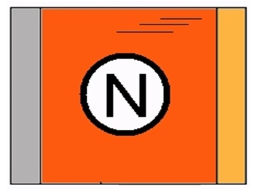 The PHYSICS, MATERIAL SCIENCE and ELECTRICAL ENGINEERING of Lattice Assisted Nuclear Reactions (Cold Fusion; an introduction) The PHYSICS, MATERIAL SCIENCE and ELECTRICAL ENGINEERING of Lattice Assisted Nuclear Reactions (Cold Fusion; an introduction)
- Lattice assisted nuclear reactions (cold fusion) is the generation of anomalous excess heat at low temperatures using an isotope of hydrogen as the fuel. The phenomenon began with explorations and experiments using a loaded palladium electrode (cathode), activated in heavy water. In March, 1989, when the achievement of cold fusion was first reported in the press, electrochemically induced reactions were very difficult to reproduce. Despite the ensuing controversy, much work has persisted.
- They are now relatively reproducible.
Swartz, M., "Survey of the Observed Excess Energy and Emissions In Lattice Assisted Nuclear Reactions", Journal of Scientific Exploration, 23, 4, 419-436 (2009).
Swartz M., Excess Power Gain using High Impedance and Codepositional LANR DevicesMonitored by Calorimetry, Heat Flow, and Paired Stirling Engines, Proc. ICCF14 1, (2008), p 123; Ed D.J. Nagel and M.E.Melich, ISBN: 978-0-578-06694-3, 123, (2010); www.iscmns.org/iccf14/ProcICCF14a.pdf
Verner, G., M. Swartz, P. Hagelstein, Summary report: ‘Introduction to Cold Fusion’–IAP course at the Massachusetts Institute of Technology, Current Science, 108, 4, 653 (2015); http://www.currentscience.ac.in/Volumes/108/04/0653.pdf
MIT Cold Fusion - The Revolution has Begun! https://www.youtube.com/watch?v=gMx1mpcokBk
MIT Scientists Discover Secret to Cold Fusion - Jeremy Rys http://www.exposingtruth.com/mit-scientists-discover-secret-cold-fusion/
- More understanding has developed regarding what the products are (including helium ), and how the reactions work at increasing power levels.
- More importantly, the technology has blossomed to include anomalous heat of both steady-state and burst type in several types of materials, and in preloaded dry materials.
Swartz, M. G. Verner, J. Tolleson, P. Hagelstein, Dry, preloaded NANOR®-type CF/LANR components, Current Science, 108, 4, 595 (2015); http://www.currentscience.ac.in/Volumes/108/04/0595.pdf
Swartz M. R., Hagelstein P.I., Demonstration of Energy Gain from a Preloaded ZrO2–PdD Nanostructured CF/LANR Quantum Electronic Device at MIT, J. Condensed Matter Nucl. Sci. 13, (2014), p 516 www.iscmns.org/CMNS/JCMNS-Vol13.pdf
Swartz M. R., Verner G., et al., Energy Gain From Preloaded ZrO2–PdNi–D Nanostructured CF/LANR Quantum Electronic Components, J. Condensed Matter Nucl. Sci. 13, (2014), p 528 www.iscmns.org/CMNS/JCMNS-Vol13.pdf
Dr. Mitchell Swartz: "Cold fusion is the fusion of two heavy hydrogen nuclei to form a helium nucleus at near room temperature. Cold fusion happens when we take heavy hydrogen and we load it into a metal such as palladium, much as water is loaded into a sponge. When the hydrogen loading reaches a certain sufficient threshold level, then all of the sites in the metal lattice that are available become filled. If we keep pushing harder, then the lattice continues to fill, and if we continue to push in a sufficient amount, then eventually, if the conditions are correct and if we actually have prepared the metal a little bit, then we know that there are certain sites in the loaded metal where these desired reactions occur. Cold fusion then does occur. Under the appropriate conditions, some of these pieces of palladium appear to generate reactions that involve heat directly from the generation of new (de novo) helium-4."
 COLD FUSION IS IMPORTANT COLD FUSION IS IMPORTANT
- Dr. Eugene Mallove: "One important implication of cold fusion is that there are, at least, 300 gallons of gasoline equivalent in every gallon of ordinary water. If you take the heavy hydrogen contained in one gallon of water, normal water that you drink, or get at the pond or the lake or the ocean, and fuse that heavy hydrogen into helium, which is what is happening in cold fusion. This gives you heat, and that amount of heat is the equivalent of 300 gallons of gasoline. That means that in only one cubic kilometer of ocean, we have the energy equivalent of the entire known oil reserves on Earth. And that means total energy independence from any localized supply of oil plus the environmental benefit of not producing CO2 and other noxious pollutants.
-
Dr. Mitchell Swartz: "For each gigawatt-day a city needs, a city must burn coal at a rate of 9,000 tons per day. And in doing that, the pollution by this old technology will make 30,000 tons of carbon dioxide (CO2), 600 tons of sulfur dioxide (SO2), and 80 tons of (nitrogen dioxide) NO2, and tons of other contaminants, each and every day. This exhaust contamination is made in conventional systems day after day. By contrast, with cold fusion producing the same amount of power, that is a gigawatt that lasts for a day, that amount of energy production would require only one pound of heavy water containing deuterium to fuel the city's needs, and that cold fusion process would produce only 4 pounds of helium exhaust."
 EARLY PROBLEMS WERE MATERIALS-RELATED EARLY PROBLEMS WERE MATERIALS-RELATED
- Drs. Martin Fleischmann and Stanley Pons initially may have underemphasized the fact that the cold fusion reactions are very difficult to prepare. Early on, considerable focused upon the use of alloys, additives, and other techniques. Some setups, materials and electrodes work and some do not. The wisdom in this field will consist of knowing the difference. Preparation of the proper materials led to higher power levels and recognition of the product - helium.
 ASH PRODUCED BY COLD FUSION REACTIONS ASH PRODUCED BY COLD FUSION REACTIONS
- Dr. Melvin Miles (China Lake, US Navy) and others have demonstrated that helium, used to fill ordinary lighter-than-air balloons, is one product generated by the cold fusion reactions, if adequate loading is achieved.
- This helium is beyond the amount which could leak in from the ambient environment.
- The helium is generated by, and linked to, the production of excess heat.
- This generation of energy -- with a safe product for a change -- is therefore quite important.
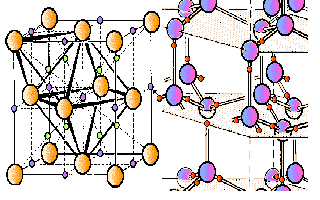
 COLD FUSION IS DRIVEN BY LOADING COLD FUSION IS DRIVEN BY LOADING
- The cold fusion reactions follow after successful loading of the metals by an isotope of hydrogen (protium or deuterium).
- In the figure on the right, the heavy water is composed of D2O molecules and is used to electrochemically load the palladium.
- The metallic palladium is on the left hand side of the figure, and is shown fully loaded.
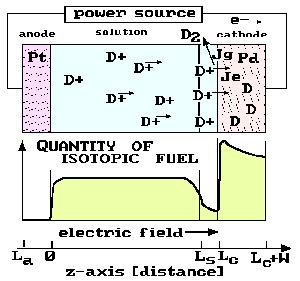
QUASI-ONE-DIMENSIONAL (Q1D) MODELS

- The applied electric field intensity produces migration in the electrolyte and loading of the metal.
- The figure [after Swartz, Fusion Technology, 296-300 (1992)] qualitatively shows the loading of the material (palladium) with the inhomogeneous distribution of isotope (deuterium obtained from heavy water) .
- Q1D models have successfully predicted that the loading of hydrogen isotopes into the metal is an effect which is actually opposite the generation of bubbles which are classically associated with electrolysis.
- One important result is that If insufficient voltage is used, or if the metal is defective (like a balloon with a moderate leak) it may simply never adequately fill.
- Another important result is codeposition which generates excess heat more quickly.
- QUASI-ONE-DIMENSIONAL (Q1D) MODEL BACKGROUND
Swartz, M, "Quasi-One-Dimensional Model of Electrochemical Loading of Isotopic Fuel into a Metal", Fusion Technology, 22, 2, 296-300 (1992).
Swartz, M., "Isotopic Fuel Loading Coupled to Reactions at an Electrode", Fusion Technology, 26, 4T, 74-77 (1994)
Swartz, M., "Codeposition of Palladium and Deuterium", Fusion Technology, 32, 126-130 (1997).
JET Energy: MORE EFFICIENT WATER HEATERS
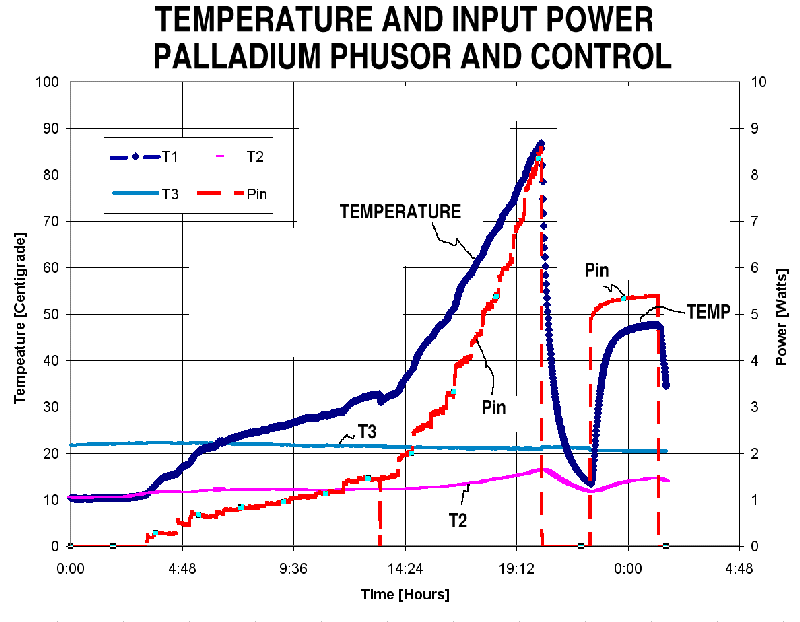
Reaction container's core temperature and input electrical power
This figure shows the results of a cold fusion system. The graph includes the heavy water reaction container's core temperature, along with the input electrical power to both the heavy water deuteron-loaded system, and an electrical control, each as a function of time. Notice that there is a control period of no electrical input, then a period of deuterium-loading of the palladium from the heavy water, then a second period of no input, then that followed by electrical input only to the electrical control [consisting of an ohmic electrical resistor for joule (thermal) heating].
It can be seen that for equivalent input electrical power that there develops a core temperature in the heavy water reaction container that is much higher in the loaded metal when compared to the thermal (joule) control.
Runs such as this, over much longer times are used to determine device performance as a function of input electrical power.

Swartz M., Excess Power Gain using High Impedance and Codepositional LANR DevicesMonitored by Calorimetry, Heat Flow, and Paired Stirling Engines, Proc. ICCF14 1, (2008), p 123; Ed D.J. Nagel and M.E.Melich, ISBN: 978-0-578-06694-3, 123, (2010); www.iscmns.org/iccf14/ProcICCF14a.pdf
Swartz M., Verner G., The Phusor®-type LANR Cathode is a Metamaterial Creating Deuteron Flux for Excess Power Gain, Proc. ICCF14 2, (2008), p 458; Ed D.J. Nagel and M.E.Melich, ISBN: 978-0-578-06694-3, 458, (2010); www.iscmns.org/iccf14/ProcICCF14b.pdf
Swartz, M, "Improved Electrolytic Reactor PerformanceUsing p-Notch System Operation and Gold Anodes, Transactions of the American Nuclear Association, Nashville, Tenn Meeting, (ISSN:0003-018X publisher LaGrange, Ill) 78, 84-85 (1998)
Swartz. M., "Patterns of Failure in Cold Fusion Experiments", Proceedings of the 33RD Intersociety Engineering Conference on Energy Conversion, IECEC-98-I229, Colorado Springs, CO, August 2-6, (1998)
From the JET Energy, Inc. Website:
EXCESS HEAT OBSERVED REPRODUCIBLY WITH TIME-INTEGRATION, NOISE MEASUREMENT, USE OF CONTROLS.
THIS IS THERMAL SPECTROSCOPY WHICH PERMITS IMPROVED SAMPLE INVESTIGATIONS
PALLADIUM SYSTEMS
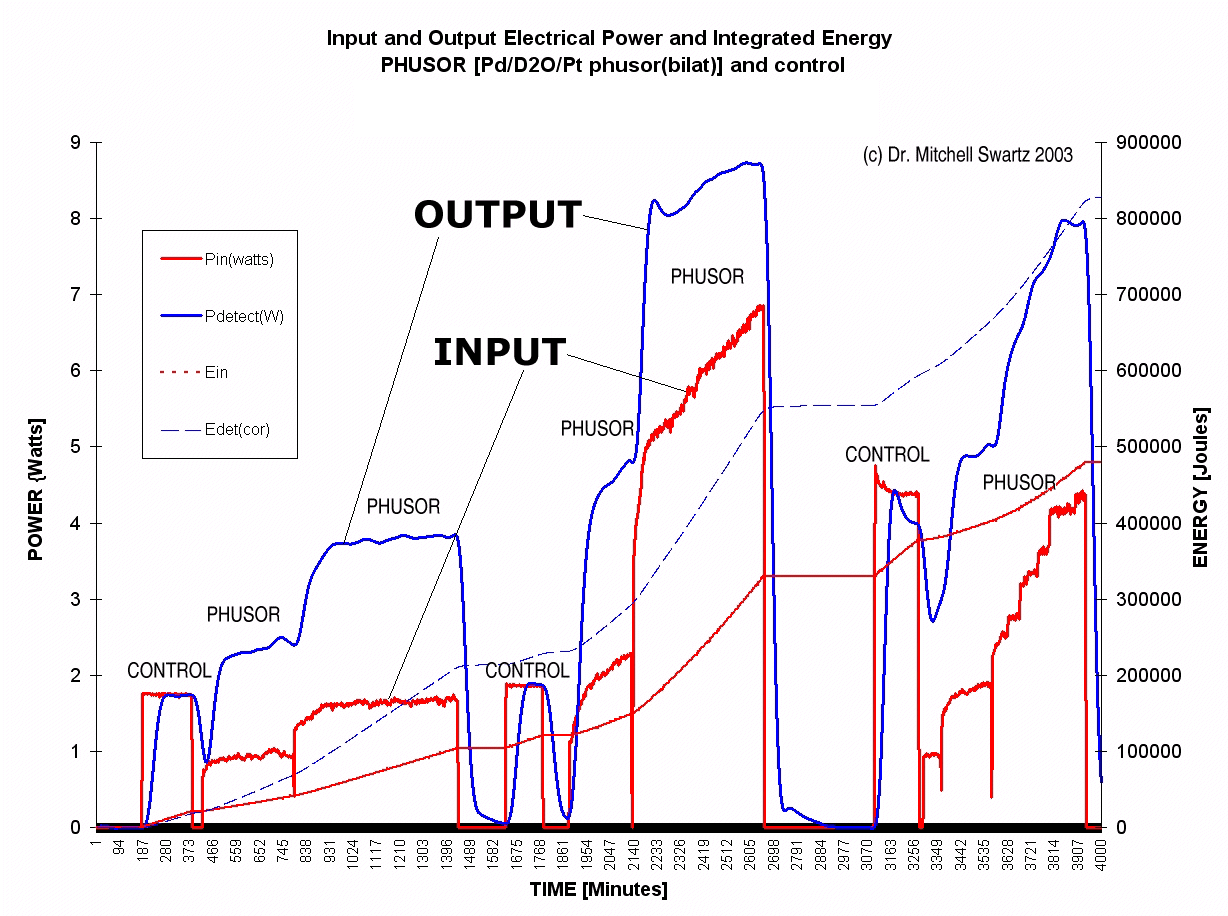 Input electrical power and observed output heat power (and energies) as a function of time for the Phusor system and the electrical control
Input electrical power and observed output heat power (and energies) as a function of time for the Phusor system and the electrical control
This figure shows the output of a moderate performance cold fusion system. The figure is a graph which has four curve.The graph shows the input electrical power and observed output heat power as a function of time over several days, both for the heavy water deuteron-loaded system and for the electrical control. Also shown, are the integrated input energy and integrated energy output of both the cold fusion device and the control, over several days.
-
- It should be noted that the observed output power is much greater for the deuterium-loaded system as compared to the thermal (joule) controls. There are two additional energy curves in the figure that corroborate the excess heat of the deuterium-loaded palladium system compared to the control. The figure shows the integrated energy curves.
- The figure shows that in this run, there was an excess heat developed of more than 300,000 joules compared to the control.
NICKEL SYSTEMS
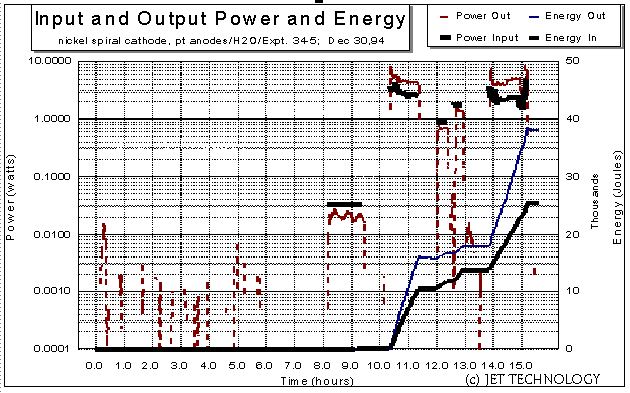
The figure above shows the input and output power (and energy) of a JET Energy, Inc. Nickel Phusor. This thermal spectrogram presents the input and output power along with energies of a platinum foil electrode (4 cm2 area) and a spiral nickel cathode (4.8 cm2 area, 0.059 cm3 volume) -- in ordinary light water. The graph results the power and energy of two JET Energy Technology generators, compared with three ohmic (Joule, or thermal) control pulses. The two solid lower lines are energy curves (input and output). They should be read off the right y-axis. The remainder of the curves are power curves and are read on the logarithmic left y-axis. The lower left shows the background noise and settling time of the experiment which characterizes the system.
 Swartz. M., "Consistency of the Biphasic Nature of Excess Enthalpy in Solid State Anomalous Phenomena with the Quasi-1-Dimensional Model of Isotope Loading into a Material", Fusion Technology, 31, 63-74 (1997)
Swartz. M., "Consistency of the Biphasic Nature of Excess Enthalpy in Solid State Anomalous Phenomena with the Quasi-1-Dimensional Model of Isotope Loading into a Material", Fusion Technology, 31, 63-74 (1997)
Swartz. M., G. Verner, "Excess Heat from Low Electrical Conductivity Heavy Water Spiral-Wound Pd/D2O/Pt and Pd/D2O-PdCl2/Pt Devices", ICCF-10 (Camb. MA), Proceedings of ICCF-10, (2003).
Swartz, M, "Improved Electrolytic Reactor Performance Using p-Notch System Operation and Gold Anodes", Transactions of the American Nuclear Association, Nashville, Tenn 1998 Meeting, (ISSN:0003-018X publisher LaGrange, Ill) 78, 84-85, (1998).
Swartz, M., "Biphasic Behavior in Thermal Electrolytic Generators Using Nickel Cathodes", IECEC Proceedings, paper #97009 (1997).
OPTIMAL OPERATING POINTS
SOME EARLY PROBLEMS
WERE OPTIMAL OPERATING POINT RELATED
- In 1997, Dr. Mitchell Swartz reported that electrodes had to be driven at a precise in the input electrical power phase space for efficient operation, and that by considering such, different samples could be evaluated with respect to each other. This is optimal operating point of each system. Comprehending the "Optimal Operating Point"--the site at which the reaction is best operated--around which each device is designed and carefully constructed has been one major key to understanding and developing cold fusion. We have learned that the reactions occur only after successful loading of an active metal by an isotope of hydrogen (reactions to the left of the peak), and that excessive input of electrical power is wasteful (reactions to the right of the peak).
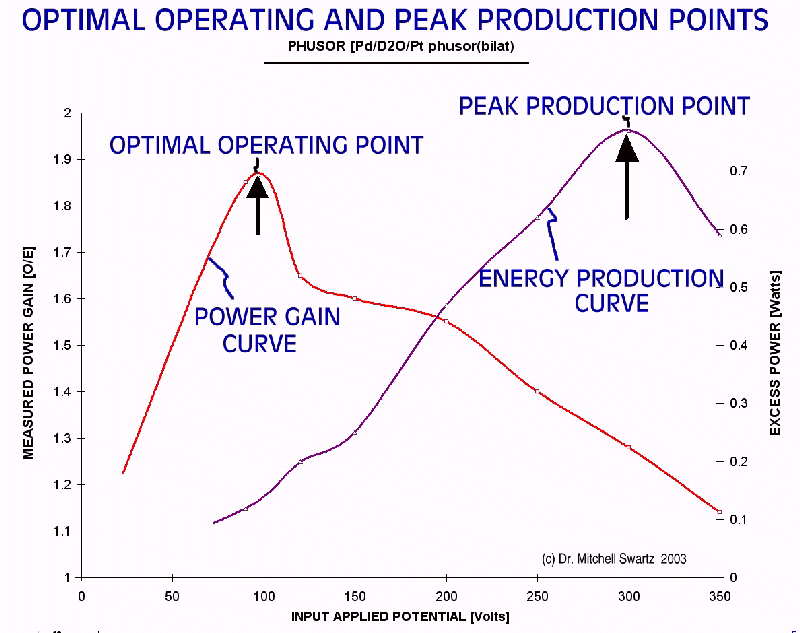
Optimal Operating Point and Peak Production Point
In a Pd/D2O/Pt Phusor System
 The figure above shows power gain and the energy production curves for a JET Palladium Phusor as a function of applied voltage across the device. As Dr. Swartz has demonstrated in several cold fusion systems, an optimal operating point can be seen. This narrow peak (maximum) of the power gain and production curve for the products is observed for the desired reactions (heat and trace amounts of helium-4) as a function of input electrical power. Driving with electrical input power beyond the optimal operating point does not improve the production of the desired product or power gain, but instead yields a less than desirable falloff of the production rate and power gain with increasing input power. The figure above shows power gain and the energy production curves for a JET Palladium Phusor as a function of applied voltage across the device. As Dr. Swartz has demonstrated in several cold fusion systems, an optimal operating point can be seen. This narrow peak (maximum) of the power gain and production curve for the products is observed for the desired reactions (heat and trace amounts of helium-4) as a function of input electrical power. Driving with electrical input power beyond the optimal operating point does not improve the production of the desired product or power gain, but instead yields a less than desirable falloff of the production rate and power gain with increasing input power.
 The failure to operate similar systems near the optimal operating point may account for some of the widespread difficulties in observing the desired reactions. The failure to operate similar systems near the optimal operating point may account for some of the widespread difficulties in observing the desired reactions.
 OPTIMAL OPERATING POINT BACKGROUND OPTIMAL OPERATING POINT BACKGROUND
Swartz. M., "Control of Low Energy Nuclear Systems through Loading and Optimal Operating Points", ANS/ 2000 International Winter Meeting, Nov. 12-17, 2000, Washington, D.C. (2000)
Swartz. M., G. Verner, A. Frank, H. Fox "Importance of Non-dimensional Numbers and Optimal Operating Points in Cold Fusion", Journal of New Energy, 4, 2, 215-217 (1999)
Swartz, M., "Generality of Optimal Operating Point Behavior in Low Energy Nuclear Systems", Journal of New Energy, 4, 2, 218-228 (1999)
Swartz, M, "Optimal Operating Point Characteristics of Nickel Light Water Experiments", Proceedings of ICCF-7, (1998).
Swartz, M, "Comparative p-notch [Optimal Operating Point] Characteristics of Solid State Nuclear Systems, Infinite Energy, 20, 69, (1998)
JET Energy's PHUSOR Technology
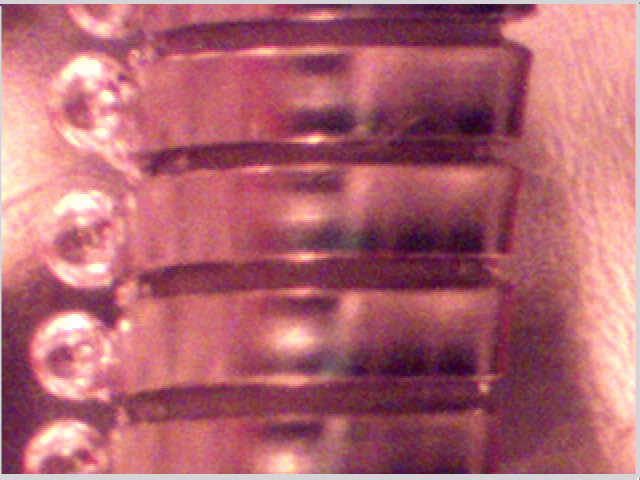
PHUSOR CLOSE UP
Asymmetric Electrolysis At a Spiral Wound Cathode
 This figure demonstrates an important finding of this system - asymmetric electrolysis which is seen on only one side of the cathode (which is facing the anode). In this high voltage system (~1500 volts), videos (including those shown at ICCF-10 by Dr. Mitchell Swartz, of which the above figure is a single frame grab) have demonstrated that cathodic electrolysis bubbling occurs, if the conditions are appropriate, almost solely on the anode-side (left hand portion of the spiral wound cathode in the photo) of this PHUSOR palladium cathode. This creates a deuteron current through the palladium electrode. This figure demonstrates an important finding of this system - asymmetric electrolysis which is seen on only one side of the cathode (which is facing the anode). In this high voltage system (~1500 volts), videos (including those shown at ICCF-10 by Dr. Mitchell Swartz, of which the above figure is a single frame grab) have demonstrated that cathodic electrolysis bubbling occurs, if the conditions are appropriate, almost solely on the anode-side (left hand portion of the spiral wound cathode in the photo) of this PHUSOR palladium cathode. This creates a deuteron current through the palladium electrode.
 Cold fusion is real. There really is a science and engineering to it. Cold fusion is real. There really is a science and engineering to it.
-
- As discussed briefly by Nobel Prize Winner, Brian Josephson in the Independent (UK) [August 2004] also states that cold fusion is real and can be used safely to generate heat with improved efficiency. In the open-minded Letters to the Editor of the Independent, regarding "Fusion alternative to fossil fuels". Prof. Brian D. Josephson wrote:"Fusion alternative to fossil fuels"
- Sir: In regard to the letter of xxx xxxxxxx (1 June), nuclear fusion already works: the way to make it work was demonstrated 15 years ago by Stanley Pons and Martin Fleischmann but an inadequate, poorly analysed experiment by rival workers specialising in high-temperature fusion led to the scientific community concluding that "cold fusion" was a delusion, and to the suppression of such investigations. Research continued in some laboratories nevertheless, and on a recent visit to the US I visited one, witnessing an apparently well-designed experiment where the heat energy output was some 40 per cent in excess of the energy put into the system. Total energy excess amounted to 48 kilojoules per cubic centimetre of electrode, an amount significantly greater than can be accounted for by any of the non-fusion mechanisms suggested by the sceptics. It should be feasible, according to Dr Mitchell Swartz of JET, the scientist in charge of the experiment, to scale up this process to provide a source of energy on a large scale that does not generate greenhouse gases and is radiation free. In frustrating such a development, the scientists who denounced the original cold fusion research appear to have done mankind a grave disservice."
Professor Brian Josephson
Department of Physics, University of Cambridge
Dr. Brian Josephson's Page
Tomorrow, preloaded LANR nanostructured materials and devices will also be useful for integrated circuits and other applications using a pre-activated nanostructured and other materials. These include high power, high-efficiency, self-contained, autocontrolled, preloaded, energy production devices and systems enabling their remote activation for electronic, bioelectronics, space and avionic circuits, IC devices, and AI systems.
|
